Hailey insists she’s too old for the holiday childcare program she’s being dropped off at. After all, she’s 12 now. It’s a boring way to spend her holiday break – until she runs into Jen, a mysterious teenager who seems to have appeared out of nowhere. The two break away from the group to explore the dilapidated shopping centre the holiday program is operating out of.
But they aren’t the only ones here. There are mysterious balls of slime that seem to be alive with something quivering inside of them, and there’s a giant egg in the mall’s flooded basement car park.
In Utero is the latest work for Australian cartoonist Chris Gooch, whose previous books – Bottled, Deep Breaths and Under-Earth – have been some of the most exciting comics to come out of Australia over the past decade.
In Utero is Gooch’s most genre-focused work to date – a coming-of-age story wrapped in an eerie creature feature, backdropped by a rotting shopping mall and a psychic realm. It’s a creepy read and a great-looking book, with cinematic panelling, expressive character work and a dual colour palette of red and blue as a way to differentiate points of view throughout the book. His backgrounds are detail-rich, whether it’s a rat’s nest of highways that crisscross the crater of a massive explosion, an abandoned shopfront or the skeleton of a giant beast in a barren wasteland.
Ahead of its release, I spoke with Gooch about the creative process behind In Utero, playing with genre and how he was influenced by the works of Katsuhiro Otomo and Digimon: The Movie.
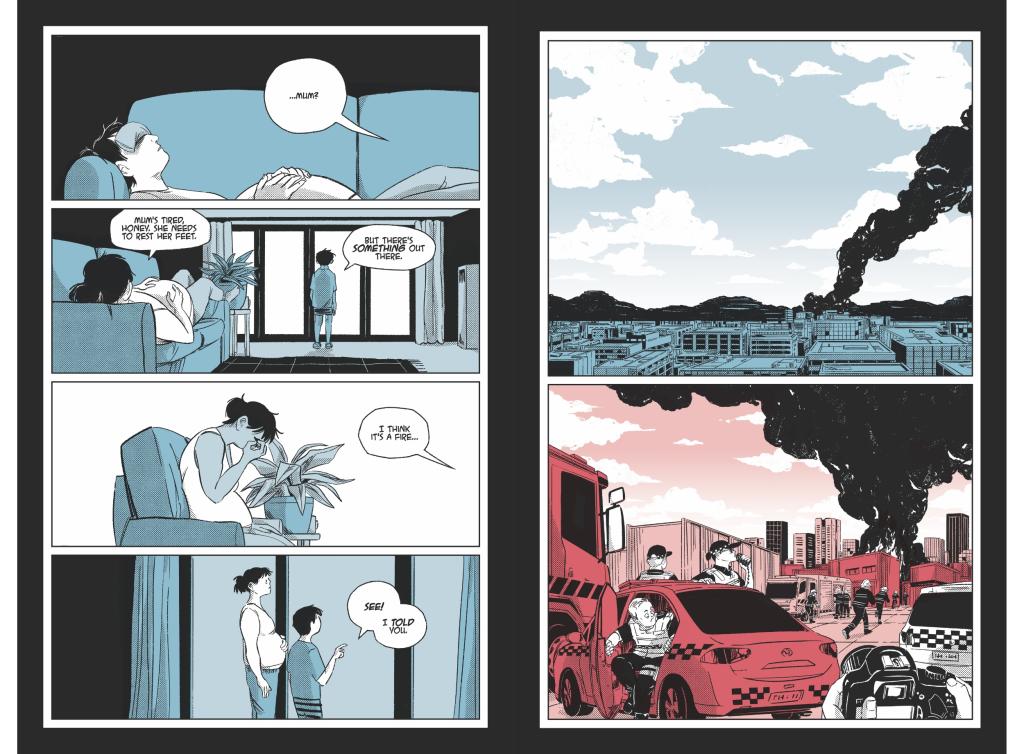
How long were you working on In Utero? Did this concept or story go through any major changes as you were putting it together?
Chris Gooch: I started it in 2020. I did an Honours year, largely because of COVID. So I did a media comms honours, for creative writing. So the comic book, the start of it was the beginning of a thesis. So I had the idea in my mind, like the sketch and then maybe a couple of pages outlined for the story. And then I wrote, it was like a 10,000-word essay about the book. The thesis process involves developing the written comic alongside a theory aspect – and theory is all about different academic horror theories.
The fact that you’ve built it out of a thesis, it was probably a much different process than when you were writing and drawing Bottled and Under-Earth?
Chris: The comic came first in the sense that I’m a comic artist and writer before being an academic or anything like that. So Priority went to the story. That basically produced a first draft, that I then went to Top Shelf with and was like, I want to do this. And they were like, “Yes, but, we don’t think it’s quite there”. So I went through a lengthy period of revisions. For a while, I think maybe like nine months – or maybe even a year – really trying to get the thumbnail draft. And they were pretty detailed. But, yeah, trying to get it to all work as a story, and after that I started drawing it.
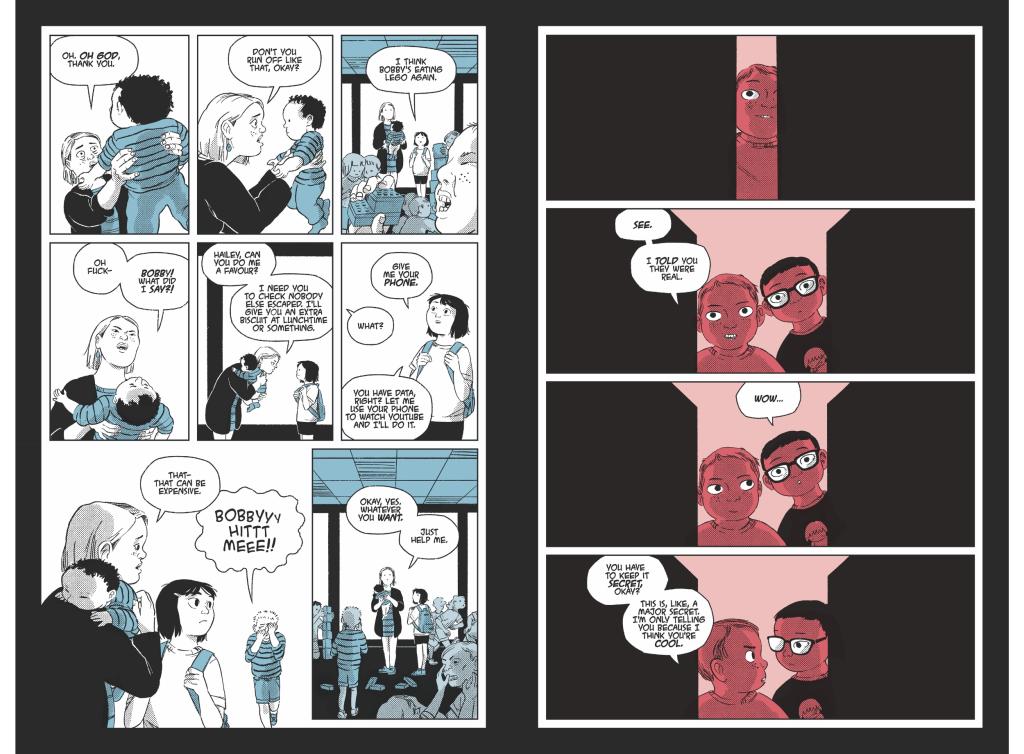
Compared to your previous long-form work, In Utero is the most sci-fi your comics have been. What was it like working in this more genre-focused space?
Chris: Fun and really lovely. I think my work, at least the next one I’m planning, will be staying in a genre vein. I like art films, but the stuff that I enjoy the most is definitely stuff with action and violence with a bit of substance as well.
While reading In Utero, I kept thinking “Chris really likes Akira“.
Chris: Yes. Specifically, Domu. I love [Katsuhiro] Otomo, for sure. I think this one definitely wears its influences on its sleeve. Its main influences are Domu and, have you seen the Digimon movie?
Yeah! I watched the dubbed version a lot as a kid.
Chris: Yeah, so the dub version, that first story, it’s basically like Godzilla meets E.T. That’s the other influence. I loved Domu and I love those first two parts of the Digimon movie by [Mamoru] Hosoda. Genre I love; you can just dip into that, you can wear it on your sleeve. You can have as much of that as you really want in there. Especially when it’s like Otomo. He’s so big; he’s everywhere, he’s in everybody’s work. I don’t think there’s any point in trying to hide it. Also in Under-Earth as well. Have you read the Akira manga?
Yes, that’s my favourite comic.
Chris: Yes, I love it. But volumes four to six, after it becomes a post-apocalyptic Tokyo, that’s definitely in there as well. I love [Otomo]. I’m very excited for the Complete Works to hopefully get an English translation.
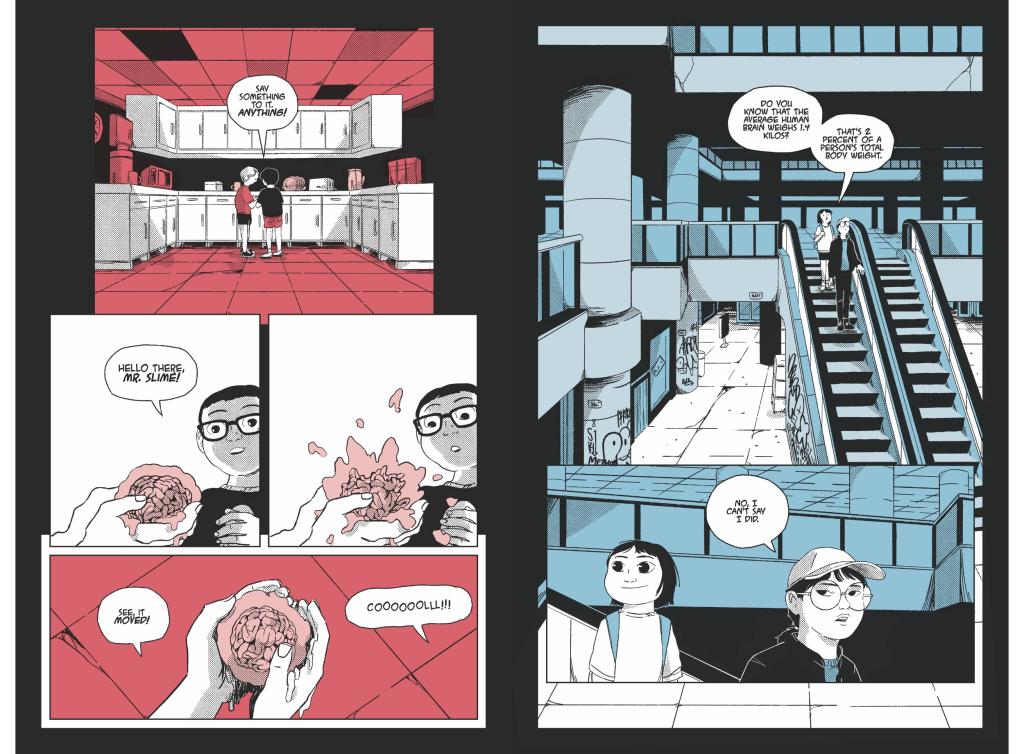
There’s a short in your book Deep Breaths where a school kid gets forced to buddy up with another kid during recess only for that kid to transform into a monster and then eat them. I was reminded of that reading In Utero because I feel like you’re exploring kind of a similar idea of being unsafe in a supposedly safe space, which is the daycare centre.
Chris: I haven’t thought about that one in a long time. I don’t know if the setting is more than I just have a memory of being in primary school and going to this weird holiday program for like a week in an office building. It was just like offices, offices, offices, and then an empty open-plan office with some old desktop computers that had that old RTS that’s really silly and has like future Russians. Red Alert?
Yeah, Command & Conquer Red Alert.
Chris: In retrospect, I was like, “What the fuck were these adults doing with these children?” They just had some office space and were like, “Yeah, okay. Let them run around”. I remember doing jousting on office chairs and stuff. That came from there. In terms of the “unsafe space”… I don’t know. The point of view is Hailey and she’s written as I remember being a child, as opposed to what it’s actually like being a child. You look at children and you’re like, oh my god, it’s amazing that they can walk and not just keep walking into a wall. It’s amazing they could do anything at all, it looks like it’s barely being held together. But my memories of being a child is like, you know that inner world and I felt like I was a real adult. She’s definitely too old to be there, struggling to find who she is. The metamorphosis and the In Utero of it all is her coming of age.
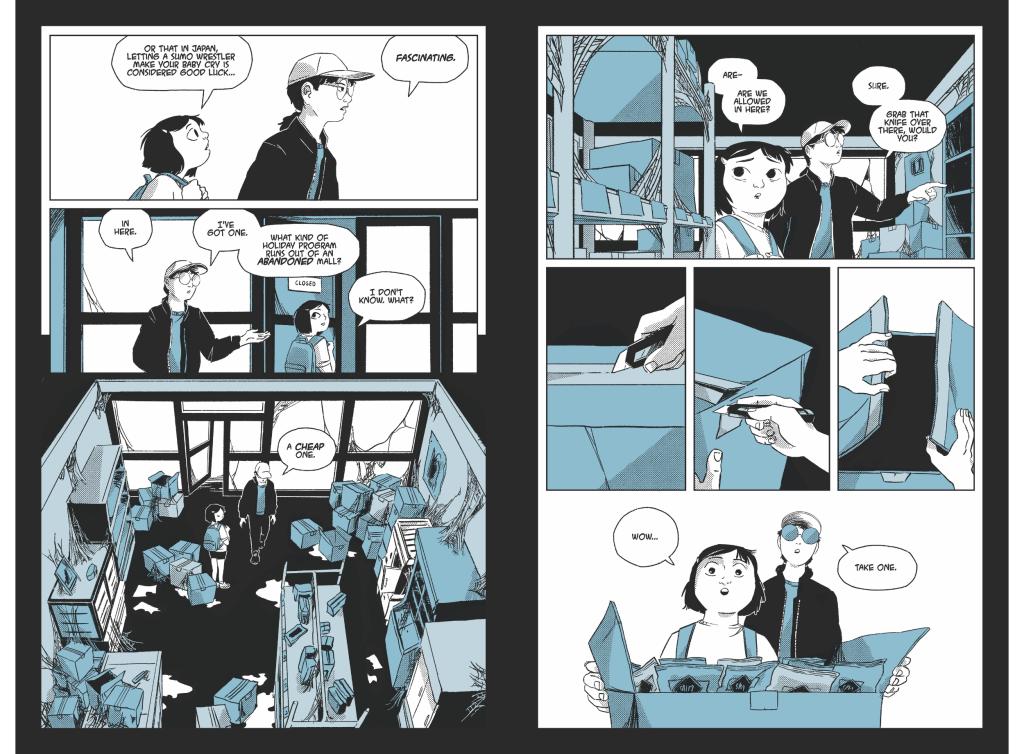
What does the concept of a “coming of age story” mean to you?
Chris: I guess just like a pivotal moment. For me, as a kid that 12 to 13[year-old] period was a big step. Primary school to high school kind of forces you, for the first time ever, to reinvent yourself in a new context. Make active choices about who you want to be and what your identity is composed of. That’s mirrored in the story.
Actually, going back to the thing about her being out of her depth, she definitely does have a moment of realisation. One of the elements I did like is Jen being the same age, but having had an actually traumatic beginning to life and all of that. I think that’s probably the emotional moment in the story where Hailey grazes up against the idea of, oh, I’m in the adult world. I’m not stuck with these babies, these children in this in this holiday program. I desperately want to be thought of as an adult and now I have to have a bit of experience in navigating that and actually go through that. That was certainly my experience as a kid, feeling like I really wanted to get to the next step, but not actually being ready for the next step, or as ready as I thought I would be.
It’s that thing of, like how you said Hailey and Jen are the same age, but Jen is presented as being this older, cooler teen. Hailey just wants to hang out with her and on some level impress her. I think everyone goes through that period when they’re a kid where they meet a cooler, older kid, and it’s just like “Oh, I want to mimic how they’re acting, because then they might think I’m a cool older kid”, despite the fact that you’re like, 10-, 12-years-old.
Chris: Yeah, for sure. Like when your friends have older siblings, and you’re like, “Oh, they’re so cool”. And you think back and you’re like, wait a second, no they weren’t.
They could just rent me GTA III from the Video Ezy, that’s all they could do.
Chris: That was the kind of cool that they were. They had a bit more access to the adult world, a bit more understanding which, when you’re a kid feels like so much knowledge. They’re a “real adult”, almost, but they don’t know shit.
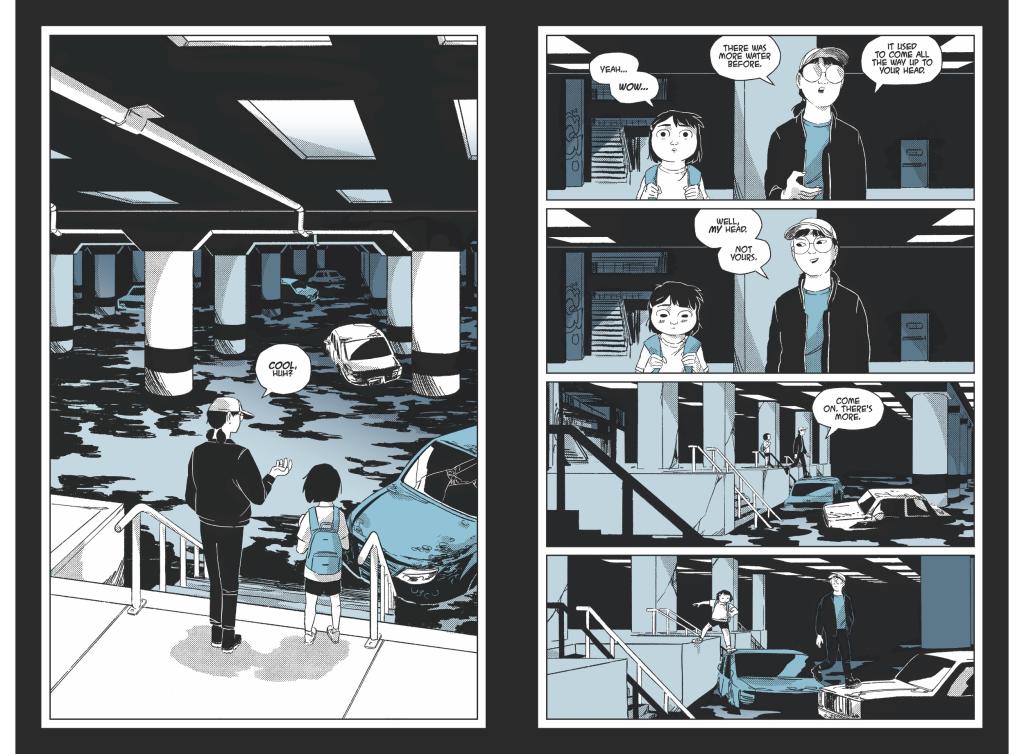
With that, I think most of the adult characters in In Utero are presented as not knowing what’s going on. There’s the bit where the woman who runs the daycare is being questioned by the military and kind of being aggressively difficult about it. The same with the General, who doesn’t really understand what he’s dealing with. Whereas Jen and Hailey seem more kind of switched on – this is a thing that’s happening, here’s how we’re trying to figure out a way to navigate through it. Yes.
Chris: That’s the other side of like, you become an adult, and then what’s possible becomes very rigid and you don’t accept anything outside of that. But just in general, I’d say a lot of the adults in the in the book are clueless or assholes or late to catch on to what’s happening, and late to figure out what’s important.
You mentioned that the Akira manga and Domu are big influences. I think In Utero touches on similar themes of those stories with the idea of a younger generation inheriting the problems and issues of the previous one, and then trying to sort it out and create a future on their own terms, not one set by the previous generation. Jen has to deal with this monster that her mother fought years ago and failed to kill, and that also becomes Hailey’s problem.
Chris: I like that reading. It’s definitely not built into it. It’s intended as more of an internal formation of identity. I can’t claim that was built in. That was more like, I wanted to have a cool monster fight.
Sometimes a cool monster fight is just a cool monster fight. Do you think you revisit these characters or this world again?
Chris: No. I’ve just turned 30 and I guess I’ve been making comics for like, 11 or 12 years. But it’s probably 10 years of hard work, really. I’ve been looking at from 30 to 40 like, what can I realistically do? I’ve got pretty finished drafts of the next two things I want to do. And I feel like they’d take four years each. So that’s kind of the next decade locked up. It’s not because I wouldn’t want to. I’d love to do a time skip and have Hailey be 18 or 20, having to fight a monster with Jen when she’s at some shit ice cream day job or in fast food service or something. I just don’t have the time left for the next decade.
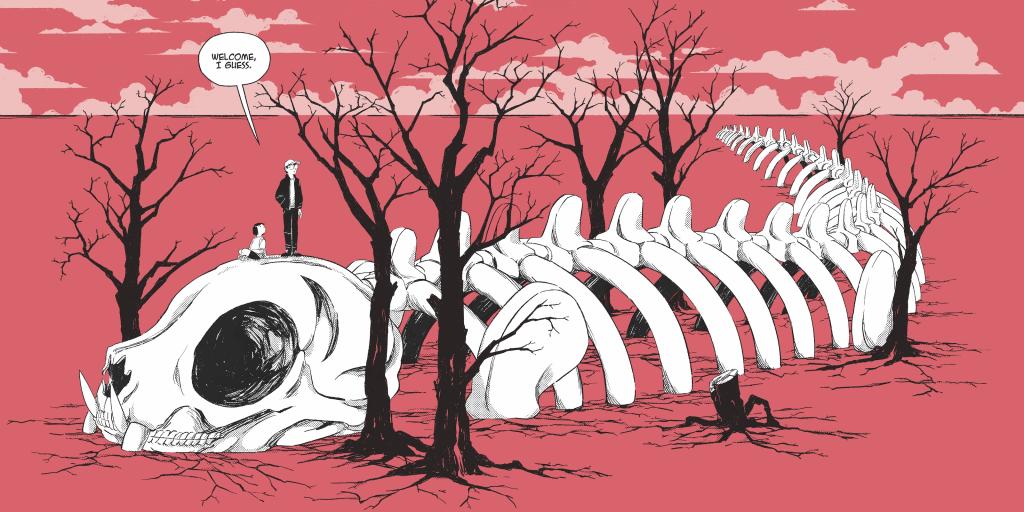
That year where Under-Earth, Home Time II and Pat Grant’s The Grot were released felt like a watershed moment for Australian indie comics, and I feel like Australian publishers have caught on to this being a thing. Do you have any thoughts about the Australian comics industry?
Chris: I feel like we’re on the precipice of a whole bunch of books being released by Australian publishers. So when I first pitched Bottled around, there maybe wasn’t as much interest or at least interest in the book that I had – or there weren’t as many examples [of Australian comics]. We’re coming up to a whole lot of Australian publishers putting out a bunch of long-form graphic novels by Australians for an Australian and international audience.
Whereas, like, Campbell [Whyte] and I, we’re with Top Shelf and there’s a couple more that still live in Australia and are published in America. Safdar [Ahmed] is a great example. His book [Still Alive] was picked up by Fantagraphics. There looks like there are a bunch of great graphic novels within the Australian publishing industry on the horizon. Buy those if you’re interested. Support them and then hopefully that continues to grow.
In Utero will be released through Top Shelf on January 23, 2024. You can find more of Chris Gooch’s work here.
Image: Chris Gooch / Top Shelf / Kotaku Australia
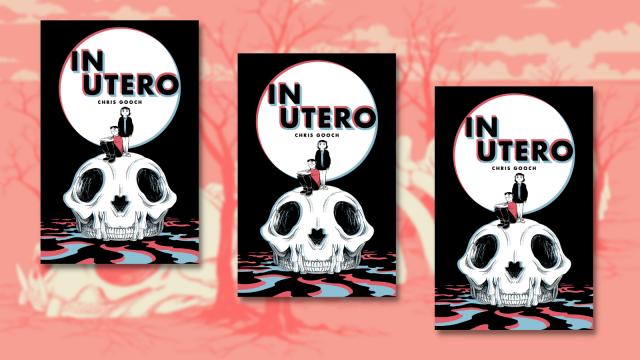
Leave a Reply